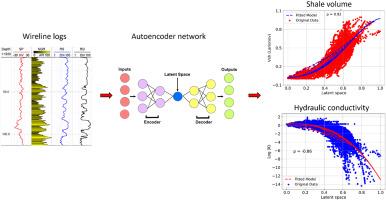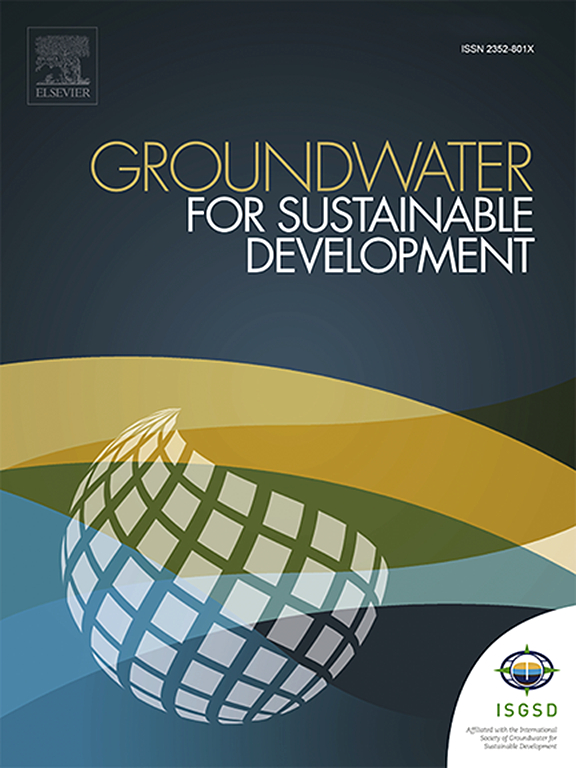利用基于全局优化的回归方法辅助半监督深度神经网络,从有线测井记录中稳健地估算水文地质参数
IF 4.9
Q2 ENGINEERING, ENVIRONMENTAL
引用次数: 0
摘要
了解含水层水文地质特性的分布对于地下水资源的可持续开发至关重要。本研究探索了深度自动编码器神经网络(AE-NN)的应用,并辅以全局优化方法来估算匈牙利德布勒森地区第四纪含水层系统的水文地质参数。估算含水层参数的传统方法通常依赖于现场实验和实验室分析,既费钱又费时,而且往往无法考虑地下水层的异质性。在这项研究中,对深层 AE-NN 模型进行了训练,以提取潜空间(LS)表示法,捕捉现有测井记录的关键特征,包括自发电位(SP)、天然伽马射线(NGR)、浅层电阻率(RS)和深层电阻率(RD)。然后,LS 测井与页岩体积和导水率相关联,分别由 Larionov 和 Csókás 方法确定。回归分析表明,LS 测井与页岩体积之间存在高斯关系,而与导水率之间存在负的非线性关系。全局优化方法包括模拟退火(SA)和粒子群优化(PSO),用于完善回归参数,提高模型的预测能力。结果表明,AE-NN 在全局优化方法的辅助下可有效用于估算页岩体积和导水率,为估算对地下水流和污染物迁移建模至关重要的水文地质参数提出了一种新颖而独立的方法。本文章由计算机程序翻译,如有差异,请以英文原文为准。

Robust estimation of hydrogeological parameters from wireline logs usingsemi-supervised deep neural networks assisted with global optimization-based regression methods
Understanding the distribution of hydrogeological properties of the aquifers is crucial for sustainable groundwater resource development. This research explores the application of deep autoencoder neural networks (AE-NN), assisted with global optimization methods for estimating hydrogeological parameters in the Quaternary aquifer system in the Debrecen area, Hungary. Traditional methods for estimating aquifer parameters typically depend on field experiments and laboratory analyses, which are both costly and time-consuming, and often fail to account for the heterogeneity of groundwater formations. In this study, deep AE-NN models are trained to extract latent space (LS) representations that capture key features from the available well logs, including spontaneous potential (SP), natural gamma ray (NGR), shallow resistivity (RS), and deep resistivity (RD). The LS log is then correlated with shale volume and hydraulic conductivity, as determined by the Larionov and Csókás methods, respectively. Regression analysis revealed a Gaussian relationship between the LS log and shale volume and a negative nonlinear relationship with hydraulic conductivity. Global optimization methods, including simulated annealing (SA) and particle swarm optimization (PSO), were used to refine the regression parameters, enhancing the predictive capabilities of the models. The results demonstrated that AE-NN assisted with global optimization methods can be effectively used to estimate shale volume and hydraulic conductivity, proposing a novel and independent approach for estimating hydrogeological parameters critical to groundwater flow and contaminant transport modeling.
求助全文
通过发布文献求助,成功后即可免费获取论文全文。
去求助
来源期刊

Groundwater for Sustainable Development
Social Sciences-Geography, Planning and Development
CiteScore
11.50
自引率
10.20%
发文量
152
期刊介绍:
Groundwater for Sustainable Development is directed to different stakeholders and professionals, including government and non-governmental organizations, international funding agencies, universities, public water institutions, public health and other public/private sector professionals, and other relevant institutions. It is aimed at professionals, academics and students in the fields of disciplines such as: groundwater and its connection to surface hydrology and environment, soil sciences, engineering, ecology, microbiology, atmospheric sciences, analytical chemistry, hydro-engineering, water technology, environmental ethics, economics, public health, policy, as well as social sciences, legal disciplines, or any other area connected with water issues. The objectives of this journal are to facilitate: • The improvement of effective and sustainable management of water resources across the globe. • The improvement of human access to groundwater resources in adequate quantity and good quality. • The meeting of the increasing demand for drinking and irrigation water needed for food security to contribute to a social and economically sound human development. • The creation of a global inter- and multidisciplinary platform and forum to improve our understanding of groundwater resources and to advocate their effective and sustainable management and protection against contamination. • Interdisciplinary information exchange and to stimulate scientific research in the fields of groundwater related sciences and social and health sciences required to achieve the United Nations Millennium Development Goals for sustainable development.
 求助内容:
求助内容: 应助结果提醒方式:
应助结果提醒方式:


